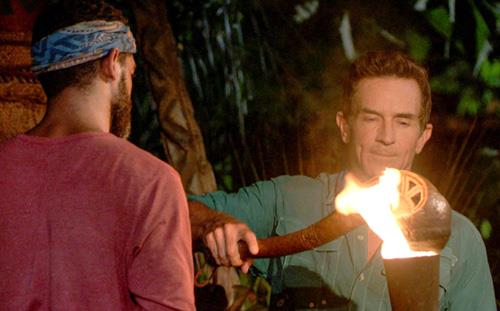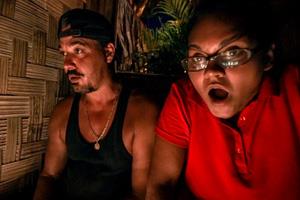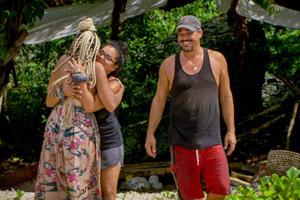
So much of TV is in-the-moment. We’re constantly rushing onto the next thing, and have little time to reflect on the past.
Streaming has opened up a whole new world of possibilities, though, and it wasn’t until I signed up for CBS All Access — having cut the cable cord this past summer — that I realized that one of the less-talked-about benefits of CBS’s streaming service is access to every, single episode of every single show CBS has owned or had a part of over the years.
One might not naturally think of Survivor as being a candidate for repeat viewing — not when the alternatives include such stalwarts as the original Twilight Zone, Hawaii Five-0 — both the Jack Lord original and the noisy, action-driven reboot — and CSI, in all its guises and versions. But those old, early seasons of Survivor were one of the first things that jumped out at me.
The thing about reality TV — that we’ve been led to believe, anyway — is that its shelf life is less than zero. Once you’ve seen a season of a reality-competition program like Survivor, why would you want to watch it again?
 I was curious, though, about those early seasons of Survivor and how they might compare to today’s edition, with the show now in its 39th cycle. The current season, which airs a new episode this Wednesday (the season finale is projected for later this month), revolves around the return of past serial winners Sandra Diaz-Twine and Rob Mariano, in the role of mentors to newcomers in the game. Clearly, Survivor has come a long way since the day Sue Hawk lectured Richard Hatch on how people behave in the real world, on a beach in Borneo in the spring of 2000.
I was curious, though, about those early seasons of Survivor and how they might compare to today’s edition, with the show now in its 39th cycle. The current season, which airs a new episode this Wednesday (the season finale is projected for later this month), revolves around the return of past serial winners Sandra Diaz-Twine and Rob Mariano, in the role of mentors to newcomers in the game. Clearly, Survivor has come a long way since the day Sue Hawk lectured Richard Hatch on how people behave in the real world, on a beach in Borneo in the spring of 2000.
Having traveled extensively throughout East Africa’s wilderness in the years Survivor has been on the air, I was curious to re-watch 2001’s Survivor Africa. The show debuted just weeks after the 9/11 terror attacks and was recently rated by one of those entertainment-zine websites as one of Survivor’s worst seasons ever.
I wanted to see if, after all these years, Survivor depicted an accurate view of what it’s like to try and survive in Kenya’s wild, semi-arid north country and whether it held up over the years as a TV show.
As someone who has watched every minute of every episode of Survivor over its run, I was startled by what I found. Survivor has undergone dramatic changes over the years, some for the good, some for the bad.
All TV shows evolve, of course, but Survivor is in a league of its own in that regard.
Consider, for example, that Mariano and Diaz-Twine, the hook behind this present season, titled Island of the Idols, are two supposed idols who were unknown to the wider public 20 years ago, whose only claim to fame is that they’ve won Survivor on several occasions. (Mariano interestingly lasted just several weeks in his debut appearance, in 2002’s Survivor Marquesas, which I watched immediately after watching Survivor Africa, again thanks to CBS All Access. Mariano was aggressive, opinionated, and full of himself, and when the tribe had spoken, his tribe-mates were happy to see the back end of him. The fact that he was invited back to the program in one of those “all-star” editions, a new person, more calculating and better at playing “the game,” counts as a kind of personal growth, I suppose, though it’s always tricky to read real-life personal growth into a situation as contrived as those that Survivor places its contestants in.)
 Watching Survivor: Africa today, it’s hard not to be struck by how genuinely arduous and draining the experience of day-to-day survival was. Northern Kenya is semi-arid desert and thorn-bush country; the contestants were dropped into Kenya’s sparsely populated Samburu District (I know, I’ve been there) with no drinking water and little food, and more-or-less told to fend for themselves. The group challenges were insanely physical, bordering on dangerous, under an equatorial sun in temperatures that edged toward 100° at times. The inevitable result, from a “game-playing” point of view, was catastrophic. The contestants became sick and dehydrated quickly, and such relatively trivial matters as alliances in the game fell by the wayside as the contestants tried to make it from one day to the next. Survivor: Africa — rated by fanzines, remember, as one of the show’s worst seasons — would change the show forever.
Watching Survivor: Africa today, it’s hard not to be struck by how genuinely arduous and draining the experience of day-to-day survival was. Northern Kenya is semi-arid desert and thorn-bush country; the contestants were dropped into Kenya’s sparsely populated Samburu District (I know, I’ve been there) with no drinking water and little food, and more-or-less told to fend for themselves. The group challenges were insanely physical, bordering on dangerous, under an equatorial sun in temperatures that edged toward 100° at times. The inevitable result, from a “game-playing” point of view, was catastrophic. The contestants became sick and dehydrated quickly, and such relatively trivial matters as alliances in the game fell by the wayside as the contestants tried to make it from one day to the next. Survivor: Africa — rated by fanzines, remember, as one of the show’s worst seasons — would change the show forever.
It’s fascinating to watch today — gritty, harsh, unrelenting and genuine, hardcore and real, and arguably a testament to the human will to survive. It’s not one of the worst seasons; it’s one of the gripping and hypnotic to watch, because you, the viewer sitting at home, get a sense of what it must be like to really be out there, in the wild, fending for yourself. When you can’t even rely on your drinking water to be safe, life takes on a whole added meaning.
Jeff Probst (top), in an interview with this reporter, admitted Survivor: Africa changed the game in profound, long-lasting ways. From that season onward, the contestants would be guaranteed access to clean, unlimited quantities of fresh drinking water. Limited amounts of food would be supplied, where there was no food easily at hand to forage. (Survivor Marquesas, the next in the series, did not provide contestants with food because the lush tropical Pacific island a day’s sail north of Tahiti, had plenty of food for foraging, in the form of coconuts and tree fruit.) Probst said it was important to the producers — and the show — that the contestants not need to worry about day-to-day survival, because Survivor’s raison d’être is the interplay between tribes and different personalities.
The continent of Africa was a fascinating but basically flawed backdrop to Survivor in those early seasons; 2008’s Survivor: Gabon, Earth’s Last Eden would prove to be the last straw. Probst said that contestants and crew — especially the crew, who he works with on a 24/7 basis throughout Survivor’s 39-day film shoots — had to put up with basic living conditions that verged on the unliveable at times. He vowed that Survivor would stick to relatively accessible tropical beach locations from then on, and in recent years Survivor has settled on Fiji as a semi-permanent film location. Probst is now a senior executive producer, too, so he gets what he wants. Also, with Survivor holding up in the ratings — even after all these years — there’s a feeling that little needs to be changed. Why mess with a good thing?
 The most profound change now, of course, is the contestants themselves. They are all Survivor fans and have watched virtually every season, minute-by-minute, on DVR and old-school videotape players, learning the ins and outs of a game that, to paraphrase the inimitable baseball guru Yogi Berra, “is ninety percent mental and the other half physical.”
The most profound change now, of course, is the contestants themselves. They are all Survivor fans and have watched virtually every season, minute-by-minute, on DVR and old-school videotape players, learning the ins and outs of a game that, to paraphrase the inimitable baseball guru Yogi Berra, “is ninety percent mental and the other half physical.”
The old innocence is gone; it’s no accident that every one of this season’s contestants so far who have met Mariano and Diaz-Twine in person practically swoons in delight at encountering Survivor stardom.
Other changes over the years included the introduction of double eliminations; hidden immunity idols — overdone in recent seasons, to the point where it sometimes seems as though there might be almost as many hidden immunity idols as coconut trees — castaway islands, where unlucky contestants are exiled in order to “find themselves” before being parachuted back into the game, more often than not with a new target on their backs; and introducing making-fire challenges as a way to break tied votes, instead of the original picking lots by blindly choosing a colored rock out of a bag (the dreaded “purple rock o’ death”).
Some of these changes are for the better, some not so much. Personally, I still find Survivor to be intriguing enough to watch every moment.
These new episodes are nothing like those early seasons, though. The whole tone of the show has shifted, from genuine survival to interpersonal dynamics and personal politics, not so much a latter-day Lord of the Flies as a reality-TV take on The Office, set on a tropical beach.
A final note: Survivor: Africa is not one of the worst seasons, no matter how much the fan sites might have you believe so. It laid the ground for the show Survivor has become today, by showing that genuine hardship, while eye-opening and revealing, doesn’t make for terrific entertainment where a reality-TV show’s long-term prospects are concerned. Club Med is more fun than Devil’s Island.